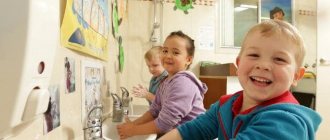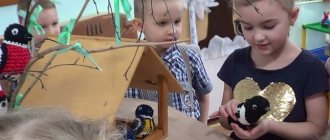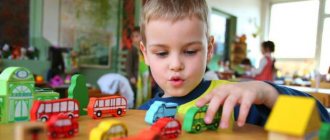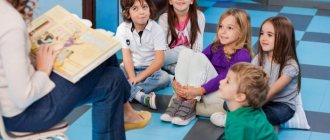Progress of the lesson
(Children sit in a circle with the teacher)
.
after class, the teacher tells all the children to go to the toilet and get ready for a walk) Guys, let’s look at the sequential dressing scheme (look at the diagram, repeat the dressing order)
.
Guys, today we will dress and undress in an unusual way, look, I have two movable belts. One with a butterfly for girls, one with a ladybug for boys. Today we will compete with you. At my command, you begin to get dressed, but do not forget that you and I are dressing in the correct sequence. Remember to be quiet, don't shout, push or rush, and leave your locker with clothes neatly folded. I will monitor your progress. Whoever gets dressed comes up to the moving ribbon and raises the butterfly or ladybug one higher, whose team gets dressed faster receives small badges. Let's start getting dressed.
“ Summary of a walk in the senior group “Birds”
»
Type of activity: Cognitive and research.
Format: group .
Goals and objectives:
1. Learn to distinguish birds by plumage, size, habits.
2. Develop observation, memory, speech; develop movements, dexterity, speed of reaction, action on a signal.
3. Cultivate an emotionally positive attitude towards birds : kindness, responsiveness, desire to help and do good deeds; hard work.
Program content:
The children go out to the site.
The teacher begins
— observation of wintering birds; name what groups birds are divided (wintering and migratory)
birds. Which birds are wintering: crow, woodpecker, tit, bullfinch, waxwing, nuthatch, capercaillie, sparrow, crossbill, etc. Migratory birds include: swift, oriole, heron, starling, nightingale, swallow, etc.
— didactic task “Who is screaming?”
;
consolidate children's knowledge about birds; chik-chirik (sparrow, kar-kar (crow), peek-a-boo (cuckoo, quack-quack (duck), knock-knock (woodpecker)
, etc.
— outdoor game “Birds in a Cage”
;
"Birdcatcher"
; teach children to act on a signal and navigate in space;
Outdoor game “Birds in a Cage”
;
Half of the children stand in a circle, holding hands, arms raised with “collars”
- this is a cell.
The second half of the children runs in and runs out into the “collar”
.
At the teacher’s signal (the cage closes), the “collars”
are lowered, the caught children name any migratory or wintering bird and leave the cage. The game is repeated 2-3 times.
Outdoor game "Birder catcher"
;
Children stand in a circle and choose a “bird catcher”
- the driver, who is blindfolded:
“One, two, three
, catch the birdcatcher,” the children run away, and the birdcatcher tries to catch someone, then they change.
The game may become more difficult with an increase in birdcatchers
.
Take-out materials: bird food, cheesecakes, sleds, ice cubes.
Labor activity: Shovels for labor activity.
Individual work: D/i “Name the bird with the right sound”
.
-Research part: observation and study of bird tracks.
The walk ends.
"Return from a walk"
— education of cultural and hygienic skills (monitor your appearance: dust off clothes, wipe shoes)
;
- fostering a sense of mutual assistance.
I draw children's attention to their appearance. I remind you that you need to hang clean clothes in lockers and hang damp ones on radiators.
“Getting ready for lunch. Dinner"
Tasks:
Educational objective:
To teach children to conscientiously perform the duties of a dining room attendant: setting the table. Learn to express your thoughts coherently and consistently, based on a diagram. Learn to evaluate the results of your work with the help of an adult.
Developmental task:
Develop dialogical speech.
Educational task:
1. Instill in children a desire to participate in joint work activities.
2.Improve cultural and hygienic skills: carefully wash and dry your hands, hang the towel in place .
3. Create conditions for improving the quality of children’s self-care activities during preparation for meals.
4. Form the habit of a healthy lifestyle (prevention of poor posture while eating)
;
5.Continue to develop a culture of behavior while eating: use cutlery correctly (tablespoon, teaspoon, fork)
; ability to use a napkin carefully; do not crumble bread, chew food with your mouth closed, do not talk while eating.
6. Follow medical prescriptions for individual nutrition.
7. Cultivate the ability to calmly wait for the next dish to be served, politeness (thank you for the food, the need for cleanliness and neatness.
8. Introduce children to a set of exercises to optimize the functioning of the digestive system.
9. Foster a conscious attitude towards health through practical mastery of a gymnastics complex.
10. Table setting: conversation with the attendants; familiarization with the menu, announcing it to children; attracting children's attention to the aesthetic design of tables.
11. Attracting children's attention to food; individual work to educate food culture; rules of etiquette; performance assessment.
12.Getting ready for bed: hygiene procedures; creating conditions for organizing sleep ; going to bed.
Preliminary work:
- Examining dishes while eating;
— Guessing and learning riddles about dishes;
— Compiling a descriptive story about a bird using a diagram.
— Reading V. Bianchi’s “Sinichkin’s Calendar”
Equipment: napkins, cutlery (spoons, forks, knife, tableware (deep plate, shallow plate, cup, bread box, napkin holder, for table setting.
Card index of cultural and hygienic skills in the senior group
Long-term plan for the education of cultural and hygienic skills
Reading: I. Ishchuk “My Palms”
Keeping clothes and shoes in order, making the bed.
Learn to dry and clean your clothes and shoes, strengthen the ability to make your bed
Didactic exercise “How to make the bed.”
Learn to eat different types of food without changing the position of the fork in your hand, but only slightly turning your hand.
Reading N. Litvinov “The Kingdom of Cutlery.”
Improve the skills of correctly placing your things in the closet, strengthen the ability to tie shoelaces, and fasten sandals.
Conversation “Every thing has its place.”
Improve your washing skills, wash your face, and dry yourself with an individual towel.
Didactic exercise “Let’s tell the kids how to wash themselves.”
Continue learning how to make the bed: straighten the blanket after adjusting the sheet.
Reading S. Mikhalkov “I myself.”
Strengthen the ability to spread butter on bread with a knife, cut off a piece of meat or sausage.
Didactic exercise “Let’s tell the kids how to use a knife correctly”
Strengthen the ability to dress and undress in a certain sequence, use different types of fasteners.
Reading I. Bursov “Galoshes”, S. Mikhalkov “I Myself”.
Exercise “Who will put the clothes correctly and quickly.”
Continue to teach how to wash yourself properly and use a handkerchief in a timely manner.
Reading K. Chukovsky “Moidodyr” (excerpts).
Improve the skills of making the bed, the ability to carefully cover the bed with a blanket.
Didactic exercise “Who will make the bed correctly and quickly.”
Conversation “How to properly eat a second course.”
Strengthen the ability to neatly fold and hang clothes on a chair, and dress in a certain sequence.
Exercise “How we can put things in order.”
Improve the skills of proper washing and using an individual towel.
Reading A. Barto, P. Barto “The Dirty Girl”.
Keeping clothes and shoes in order, making the bed.
Continue to teach how to dry and clean your clothes and wipe your shoes
Conversation “How to take care of your clothes.”
Strengthen the ability to eat the second course.
Improve your ability to use a napkin as needed.
Conversation “Culture of behavior while eating.”
Teach children to independently maintain cleanliness and order in their closet.
Conversation “How we clean up our closet”
Improve your ability to wash your face quickly and correctly.
Progress of the regime moment
Children are seated on chairs at tables that are appropriate for the child’s height and “mealtime seating pattern.”
, the teacher talks about what is offered to the children for breakfast today,
(breakfast menu)
wishes them a bon appetit and once again repeats the proverb
“Appetite comes with eating
.
The teacher pays attention to posture while eating and carries out individual work to consolidate the skills of using cutlery.
Q: Officers, what are we having for breakfast today?
D: Wheat porridge, bread with butter and cocoa.
Q: Guys, let's remember in which hand we hold the spoon?
D: In the right hand. And I hold it in the left.
Q: The one who is right-handed holds a spoon in his right hand, and the one who is left-handed holds a spoon in his left. Yura is left-handed, which is why he holds the spoon in his left hand.
Guys, before you start eating, I want to see if you know how to hold a spoon correctly. Show me, take the whole spoon in your hand. (Children take a spoon in their hand)
Guys, not all of you took the spoon correctly. Look how I hold a spoon (the teacher shows how to hold a spoon correctly)
.
My thumb is on top, and my index and middle fingers are on the bottom, helping my thumb to hold the spoon. Now take the spoon correctly (the children take the spoon correctly, the teacher walks by and looks to see if everyone has taken the spoon correctly). Today at breakfast I will observe who held the spoon correctly, who sat correctly, and kept order on the table. He will receive this medal (the teacher shows the medal)
. Then you show it to your parents and tell them why you got it.
Guys, I wish you bon appetit!
D: Thank you!
(The children are having breakfast, and the teacher in a low voice reminds them of the rules of behavior at the table)
Q: We eat carefully, take our time.
Guys, be a little quieter. You are not alone, if you speak all at once and so loudly, you will not hear each other. Remember that first we chew food and only then talk, you can ask for something.
Take the porridge with a spoon from the side that is closest to you. Masha, sit up straight, put your feet together.
Ira, remember how to hold a spoon correctly. (The teacher approaches Ira and shows her how to hold a spoon)
.
Guys, be sure to eat all the porridge, it contains a lot of vitamins. Eat porridge and you will be strong and healthy, you will have a lot of strength and energy for the whole day.
Today at breakfast Kirill held the spoon correctly, his table was clean Masha, Olya, well done Eva, Andrey. They will receive medals. Now I’ll see who I can give medals to.
Those who have eaten, take your plates to the first table . The attendants will remove napkins and plates of bread from the tables.
"Preparation for class"
Class duty
• Check the readiness of workplaces for classes, supplement the workplaces with material missing for classes
• Develop labor skills and abilities;
Materials for the lesson: Flashcards, with pictures of birds, presentation, quizzes.
Direct educational activities (educational areas)
:
1. Cognitive development. Ecology. Topic: “Feathered friends”
Goal: To form children’s ideas about wintering and migratory birds. Learn to solve riddles. Develop interest in the world of birds, curiosity. Give an idea of the importance of birds for the environment. Develop attention and creativity. To create in children a desire to take care of birds.
Materials for the lesson: Landscape sheet, gouache paints, watercolors, brushes, a jar for water, oilcloth.
2. Artistic and aesthetic development. Unconventional drawing. Topic: “Fairytale bird”
(palm drawing)
.
3. Physical development. Physical education on the street (according to physical training plan)
"Free activity of children"
Children's games of choice. Quiet games at the tables. Construction sets , various educational games.
Individual work is carried out:
- develop logical thinking and the ability to prove the correctness of one’s actions.
Didactic game “Count the birds”
- consolidate geometric shapes, develop logical thinking.
Didactic game “Collect a picture”
"Dressing"
,
“Undressing” (for a walk, from a walk)
Tasks:
— Ensure that all children are ready for a walk in a timely manner.
— Form the correct sequence when dressing, carefully fold things
— Consolidating children’s ability to dress independently for a walk and undress after a walk in the correct sequence.
— To consolidate children’s knowledge about spring, the signs of spring.
- Cultivate a friendly attitude towards each other, mutual assistance.
— Cultivate a caring attitude towards things.
Materials: sequential dressing scheme for the spring period, mobile tapes.
Preliminary work:
— Observing the weather while walking, outside the window.
— Examination of illustrations.
— Conversation with children “How to dress in spring”
.
Preview:
Summary of routine moments in the 1st half of the day in the middle group (morning reception, washing, feeding, preparing for a walk (dressing), returning from a walk (undressing), preparing for bed and going to bed).
Goal: to promote an emotional mood for the whole day, to ensure a calm separation of children from their parents.
Equipment: various toys.
In 10-15 minutes I come to the group, ventilate the room, prepare the toys.
I greet each child kindly and greet him and his parents with a smile. I ask the parents: “How did the child sleep?”, “How is he feeling?”, “In what mood did he go to kindergarten?” or I ask the child himself: “Well, how are you? Will you play with us today?
Then I bring the child into the group and offer him an activity (dolls, cars, cubes, mosaics). During the reception, if the child does not want to part with his parents, I use musical and ).
Goal: promote health, formulate a washing rule.
While the nanny is putting breakfast on the tables, I call 2-3 children who are eating slowly and say: “Guys, do you want your hands to be clean? Let's wash them."
I take the children to the washbasin and say: “We roll up our sleeves so as not to get them wet, and now open the tap with warm water. I make sure (if necessary I help) that the children open the tap. When water started flowing in all the taps, I use a literary word:
Clean water is flowing. We know how to wash with you - We put our hands under the water with a boat (I show it to the children). Now take the soap and lather your hands in a circular motion. They washed their ears with soap, they washed their hands with soap, these are the little hands, little hands, little hands.
— We put our hands under the water again and rinse off the soap well. Shake the remaining water into the sink and turn off the tap. Now everyone goes to the towel and wipes their hands dry on all sides, we hang the towel back in its place. So our hands have become clean!
I also continue to call the remaining children one by one, help them and use artistic expression.
Goal: to promote the formation of rule of behavior at the table.
Conduct: “Children, everyone who has washed their hands, sit down at the tables. Sit up straight, put your legs straight, do not put your elbows on the table. Everyone is sitting upright, Legs are standing together, Eyes are looking at the plate, Elbows are removed from the table, The children are eating quietly. Children! Came to visit today
Came to visit today - Good Appetite! Bon Appetit everyone!"
While eating, I make sure that the children hold the spoon correctly, sit up straight, and eat silently.
I tell you how beneficial it is when children eat: they grow quickly and never get sick.
For children who don't eat, I try to convince them that they need to eat at least a little (unless they have a reason not to eat).
I help those guys who eat slowly or don’t know how to eat.
To the child who has eaten, I say: “Dasha, take a napkin and wipe your mouth, don’t forget to say “thank you” and push up the chair.”
Preparing for a walk (dressing)
Goal: to ensure that all children are ready for a walk on time.
Before going out for a walk, I remind the children to go to the toilet. Then I take a group of children and we all go out to the locker room together.
I make sure that children dress properly for a walk, observing the principle of gradualness: tights, socks, pants, boots, jacket, hat, jacket, mittens, scarf.
During this I use a literary word:
Let's dress in order
We get used to order.
- Danila, what color are your pants?
- Vanya, what do we put on our heads?
If the children cannot answer, I help them.
I encourage the children to dress themselves: “Kolya, show me how you can put on your pants.”
— Children, in order for our clothes to be clean, we need to walk carefully and not run through puddles.
Returning from a walk (undressing)
Goal: to ensure timely arrival from a walk.
I ask all children to wipe their feet when entering kindergarten (I show them how to do this).
- How cheerful you all are when you came back from your walk! Do you want to go to a group to play? Let's carefully undress.
I make sure that all the children undress correctly and neatly, and I help any of the children who need help.
- First we take off the jacket, then the hat, jacket, pants, boots, tights and, finally, socks.
I make sure the children are neat after a walk: “Dasha, look how dirty your pants are!” What kind of pants did you wear?” (clean).
I also turn to other children: “Yulia, what are you filming now? Christina, where will you hang your jacket?”
Goal: to contribute to the formation of rules of conduct.
I take the children one by one to the toilet, then to the bedroom.
- Guys, we played so well today and our hands, eyes and legs are tired and want to rest. Take your chairs and let's undress. Children, does everyone remember how to fold their clothes on a chair? I help the children undress. I put the children in bed first because they take longer to fall asleep. Let's put a soft feather bed under the back. On top of the feather bed, a clean sheet. Put white pillows under the ears. And cover with a blanket so that the children sleep soundly.
- Guys, who have undressed, lie down in bed and cover yourself with a blanket. When all the children are lying in bed, I say in a calm, quiet voice: So people are sleeping, Here are animals sleeping. Birds sleep on branches, Foxes sleep on hills, Hares sleep on grass, Ducks sleep on ants, Children are all in their cradle... They sleep and sleep, they tell the whole world to sleep. Now we lie down on our side and close our eyes. Pleasant dreams! While the children are sleeping, I keep an eye on them (so that they don’t open up, so that they don’t fall).



